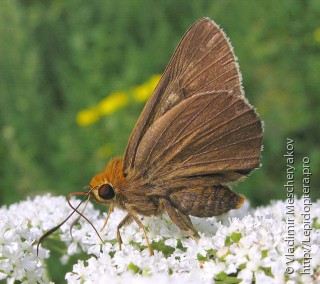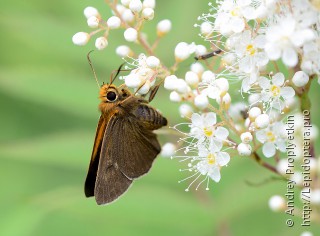Bibasis aquilina (Speyer, 1879)

Taxonomy
class Insecta → subclass Pterygota → infraclass Neoptera → superorder Holometabola → order Lepidoptera → superfamily Papilionoidea → family Hesperiidae → subfamily Coeliadinae → genus Bibasis → species Bibasis aquilina
Species name(s)
Bibasis aquilina (Speyer, 1879) = Ismene aquilina Speyer, 1879 = jankowskii Oberthür, 1880 = Burara aquilina = Ismene jankowskii Oberthür, 1880. [3, 9, 187]
urn:lsid:insecta.pro:taxonomy:14640
Expansion
This species marks on the maps: 2.
Zoogeographical regions
Palaearctic.
Russia regions
#40. Primorsky.
Forewing length
20—23 mm.
Wingspan
38—47 mm.
Flight time
| January | February | March | April | May | June | July | August | September | October | November | December |
Over-wintering stage
Larva.

Detailed information with references
Distribution
- Regions of the Russian Federation: Seaside. [3].
- Outside Russia is known in the Northeast and Central China, on the peninsula of Korea and Japan.
View environmentally timed to mesophytic deciduous and fir-broad-leaved forests in the river valleys and low mountain slopes.
Butterflies are found locally. The area of distribution in the Maritime region practically coincides with the local habitat kalopanax. [96].
Imago Habitus and Differences from alike species
- Length of front wing 20-23 mm. Wingspan 38-47 mm. The wings on the top side - brown with yellow at the base of the wings and on the costal margin of the front wing with reddish ocher, pollination.On the front wings at the end of a discoid cell blurred dark spot, and between the veins in the discal area are weak illumination, arranged in one row. The underside of the wings of a brownish color, but enlightenment in discal area more vibrant, with a clear boundary. The rear edge of the front wing lighten.The rear wings on the underside of the plain. The female differs from the male by the presence of a bright yellow spot at the end of discoid cells and median band of yellowish spots separated by veins on top and bottom of the front wing. The head and chest of the male on top covered with reddish-ocher hairs.Antennae c spindle mace, which is curved hook [8].
General info about Imago
- Butterflies prefer to stay under the forest canopy, are found on the edges, shade the roads from forest streams. Often seen on the moist soil, fallen tree trunks and the like, which consume moisture. During flowering ryabionolistnogo Fieldfare (Sorbaria sorbifolia) willing to visit its flowers. Attend as flowers umbrella, Aralia [8].
Imago lifespan
- One generation, the flight of the second decade of July to mid-August [2].
General info about Larva
- Caterpillars of older live in a typical shelter (house) - a nest of leaves, is a flattened edge inversion leaf or bent its blade to pull together at the edges with silk threads. They pupate in the fodder plants in the clump of leaves loosely connected [96].
- Caterpillar before pupation grayish-brown with reddish-orange head and a few longitudinal light lines [2].
Larva food plants / other food objects
- Kalopanax septemlobus (kalopanax seven-bladed or dimorfant) from the family Araliaceae (Araliaceae) [96].
Pupa
- Pupa light brown, densely covered with white bloom, in a rare weaving silken feed. extensible. [2].
Egg
- Females lay eggs on the leaves of mature trees kalopanax, usually in the old shelter caterpillars. [96].
Overwintering stage
- Caterpillars overwinter in the second age of web cocoon on the bark of host plants [96].
Subspecies of Bibasis aquilina
- Bibasis aquilina chrysaeglia (Butler, [1882]). [9]
- B. a. siola Evans. [9]
Authors
Initial species uploading to the site: Peter Khramov.
Photos:
Vladimir Mescheryakov, Andrey Proplyetkin. Text data: Peter Khramov, Irina Nikulina.
The species characteristics formalization: Peter Khramov, Sergei Kotov.
References
- [2] Коршунов Ю. П. Булавоусые чешуекрылые Северной Азии. М.: КМК, 2002
- [3] Каталог чешуекрылых (Lepidoptera) России. Под ред. С. Ю. Синёва. СПб.; М.: Товарищество научных изданий КМК, 2008
- [8] Красная книга Российской Федерации (Животные). М.:Астрель 2001
- [9] Tree of Life (funet.fi), 2012
- [96] Красная книга Приморского края. http://redbookpk.ru/
- [187] Species 2000, http://www.sp2000.org
Comments
Note: you should have a Insecta.pro account to upload new topics and comments. Please, create an account or log in to add comments
Bibasis aquilina photos
Other species Bibasis












